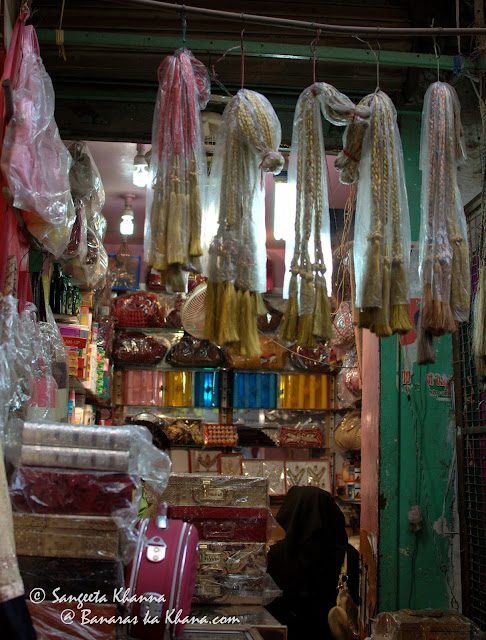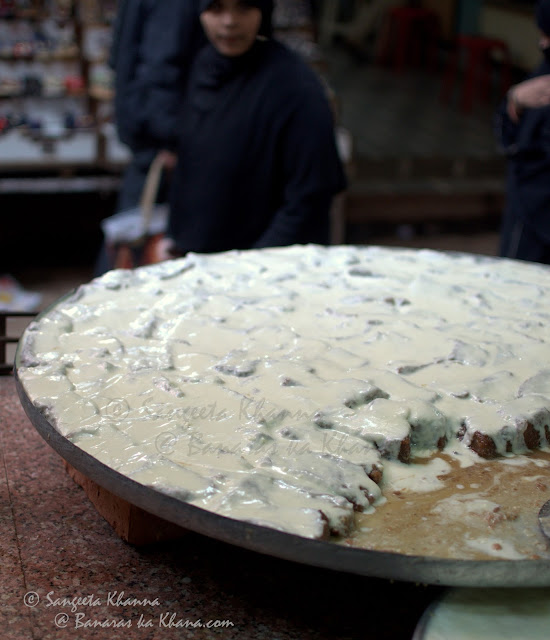No tourist or traveler visiting Banaras thinks of going to Dalmandi. Most of them have never heard about this bustling place but I am always a little curious about this old world market located in the heart of the city, quite hidden from the general visitor.
Dalmandi is a long winding gully that has a few tributary gullies interlinked with other old markets but the two main ends of dalmandi are located such that you would easily miss locating them while passing by.
May be Dalmandi was well camouflaged and hidden because of the Tawayafs or nautch girls it was known for about a century ago. If you look up the old buildings you will still see highly adorned low set windows, often painted in different bright colours. These low set windows were the show windows for the nautch girls and the Dalmandi bazar below must have been as bustling as ever.
One end of dalmandi is at the main Chowk market and the other end is in the mid of Nai Sarak. You would not be able to gauge what is awaiting you inside this gully called dalmandi. The hustle bustle of the shoppers and the shopkeepers, small shop doing big business and of course a deluge of bling all over. You would easily know that more women come to this market than men. But may be that's not true.
Dalmandi is known for the bling, the garish display of women's trinkets and loads of dresses and surplus fabric or leftover fabric from factories etc. These kind of stuff is available throughout the year but during a few festivals Dalmandi is adorned by different colours.
Dalmandi is also known as a market for kites, firecrackers and cheap glass utensils. On my last visit during Makar Sankranti I saw a deluge of Kites if all colours and sizes, patang and manjha or guddi-latayi as it is called in local parlance.
During Diwali you would find rows and rows of firecrackers being sold. Now probably the firecrackers will be lesser in numbers because the licensing for selling firecrackers has become strict.
Dalmandi is also famous for the thinnest possible Sewaiyyan and Feni. I always wonder what kind of machinery they use for making these.
These thin sewaiyyan are available in roasted version that can be mixed directly in sugar syrup, milk solids and nuts etc. to make sookhi sewaiyyan or sewaiyyon ka muzaffar.
And the white raw version that is valued by the home cooks who want precision in their recipes and prefer roasting the sewaiyyan slowly with ghee to get the best possible aroma in their sewaiyyon ka muzaffar.
The Feni available here in Dalmandi comes on many versions. Sweetened, unsweetened, white or saffron coloured, all the versions selling like hot cakes.
The other eatables which you find in Dalmandi and nowhere else in Banaras apart from Madanpura during Ramzan, are a few maida based deep fried pastry.
These super crisp biscuits called as khaste are just too rich for anyone like me but a great favourite of some. I saw people buying them in kilos.
This version of shakkarparey is huge and lightly coated with sugar syrup. You wouldn't find these anywhere else in the city.
The sohan halwa, made with loads of ghee, maida and sugar with nuts is a Muslim specialty and can be seen only in Dalmandi.
These mithai shops in Dalmandi sell other popular mithais too, such as Rasgullas, Gulabjamuns, Boondi, Son Papdi and Imartis but the quality of the specialty of this place is the Muslim food.
There used to be a few shops selling classic kabab paratha and gosht ki tikia, Biryani, keema paratha etc. But now you see the shops have changed a bit and have started selling the usual gajar ka halwa, Mung ka halwa, chiwda matar and chaat etc which was not so common to find in Dalmandi.
The gajar ka halwa in one of the places looked like this.
They had rich Mewe ka halwa too which is basically a mixed nuts halwa made rich with some dehydrated milk as well.
We found a very interesting Lassi shop that had thick and heavy Shahi tukdas loaded with malai (clotted cream).
The amount of clotted cream on the shahi tukda can make you feel sick if you don't like cream or malai, but if you like it you will be in a blissful state.
Look at the size of this platter. Bigger than a regular sized coffee table in fact.
This shop had sakoras (earthen bowls) of clotted cream as well, served with or without sugar.
The kabab paratha and keema paratha shops have now adapted themselves to serve chicken tikka and seekh kabab, the restaurant style 'Mughlai food' which was never found in these traditional Awadhi style Muslim eateries.
This shop owner said they still make bade ke gosht ki tikia (buffalo meat kababs) in the evenings but the chicken tikka and seekh kabab sells more now.
Thankfully rumali roti is made the same way.
I am not sure what all had changed in Dalmandi since the last 30 years or so I have known this place. It looks similar and even smells and sounds similar when you trudge along, but the trends have definitely started creeping in. We could feel it in the food being sold and the kites being made out of plastic and not paper like older days.
Dalmandi is still a well preserved slice of old world.


































Dalmandi looks very inviting to me Sangeeta, by way of your words and pictures.
ReplyDeletewishing to visit it some day.
Thank you Kirti. We really need to visit older cities more :-)
DeleteAmazing blog! I havebeen visiting it once in a while for a couple of years. I am an odiya, grown up in bihar, married in eastern Rajasthan and studied and lived in 3 more states now. But i like to understand the flavours of the place i am in, especially through the heirloom recipes and gali-mohallas. Loved this post!
ReplyDeleteThanks Sharmishtha.
DeleteStill those tawayaf working there or shifted.
ReplyDeleteThey are still there but if they work in the same place I am not too sure.
Delete